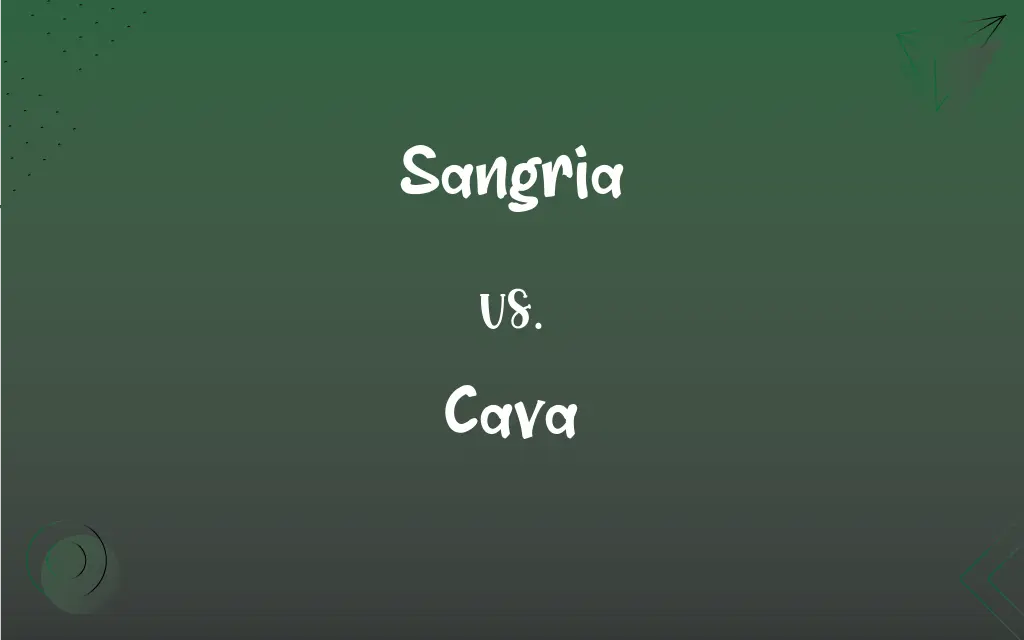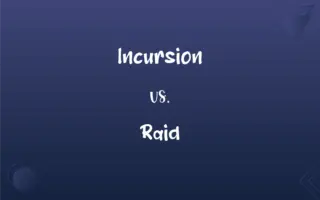Sangria vs. Cava: What's the Difference?
By Aimie Carlson & Harlon Moss || Updated on May 29, 2024
Sangria is a fruity, wine-based punch, while Cava is a Spanish sparkling wine similar to Champagne.

Key Differences
Sangria is a traditional Spanish beverage made from red wine, chopped fruit, and often additional ingredients like brandy or soda water. It is a popular choice for social gatherings and is served chilled, making it a refreshing option for warm weather. Cava, on the other hand, is a sparkling wine from Spain, produced using the same traditional method as Champagne. It is made primarily from Spanish grape varieties like Macabeo, Parellada, and Xarel·lo.
While sangria is a more casual, customizable drink, cava is often associated with formal events and toasts. Sangria's flavor profile is more complex due to the infusion of fruits and other ingredients, whereas cava's appeal lies in its pure, effervescent quality. Both beverages showcase the diversity of Spanish drinks but serve different purposes and occasions.
Sangria is often homemade, with recipes varying widely based on personal preferences and available ingredients. This variability allows for creativity in its preparation, making each batch unique. Cava, in contrast, is produced in wineries under strict regulations to maintain quality and consistency, ensuring a reliable taste experience.
Sangria’s roots are in Spain and Portugal, with historical ties to Roman times when wine was mixed with water and herbs. Cava’s history is more recent, emerging in the 19th century as Spanish winemakers sought to create a sparkling wine to rival Champagne. Despite their differences, both sangria and cava represent the rich cultural heritage of Spanish winemaking.
Comparison Chart
Type
Wine-based punch
Sparkling wine
ADVERTISEMENT
Main Ingredients
Red wine, fruit, brandy, soda
Macabeo, Parellada, Xarel·lo grapes
Serving Occasion
Casual gatherings
Formal events, celebrations
Flavor Profile
Sweet, tangy, fruity
Crisp, dry, effervescent
Production
Homemade, customizable
Wineries, regulated production
Sangria and Cava Definitions
Sangria
A mixed beverage often including brandy and soda.
The sangria had a pleasant kick from the added brandy.
ADVERTISEMENT
Cava
A Spanish sparkling wine made using traditional methods.
They toasted the new year with glasses of cava.
Sangria
A Spanish punch made with red wine and fruit.
She served sangria at the summer party, filled with fresh berries and citrus slices.
Cava
A sparkling wine that follows strict production regulations.
Cava's quality is maintained through rigorous production standards.
Sangria
A refreshing drink typically served chilled.
We enjoyed a cold glass of sangria on the hot afternoon.
Cava
A wine produced primarily from Spanish grape varieties.
Cava's unique flavor comes from grapes like Macabeo and Xarel·lo.
Sangria
A popular drink for festive occasions.
Sangria is a staple at Spanish festivals and gatherings.
Cava
A drink known for its fine bubbles and dry taste.
The cava had a crisp, refreshing finish.
Sangria
A customizable punch with various fruit and spirits.
Each sangria recipe can be tailored with different fruits and liqueurs.
Cava
A beverage often enjoyed at celebrations and toasts.
We opened a bottle of cava to celebrate the promotion.
Sangria
A cold drink made of red or white wine mixed with brandy, sugar, fruit juice, and soda water. Also called sangaree.
Cava
A sparkling wine made from a blend of grapes, produced primarily in and near Catalonia.
Sangria
A cold drink, originating in Spain, consisting of red or white wine, brandy or sherry, fruit juice, sugar and soda water and garnished with orange and other fruit.
Cava
Alternative case form of Cava, a Catalan white sparkling wine.
Sangria
(color) A deep red color.
Cava
(anatomy) vena cava.
Sangria
Sweetened red wine and orange or lemon juice with soda water
FAQs
What is the main difference between sangria and cava?
Sangria is a fruity wine-based punch, while cava is a Spanish sparkling wine.
Can cava be used in cocktails?
Yes, cava is often used in cocktails like mimosas or bellinis.
What fruits are typically used in sangria?
Common fruits include oranges, lemons, apples, and berries.
Can sangria be made with white wine?
Yes, white wine can be used to make a variation called "sangria blanca."
Is sangria always sweet?
Sangria is generally sweet but can be adjusted to taste with different fruits and mixers.
Is cava similar to Champagne?
Yes, cava is made using the traditional method used for Champagne but with different grapes.
How is cava produced?
Cava is produced using the traditional method, with a second fermentation in the bottle.
Can sangria be made ahead of time?
Yes, making sangria ahead of time allows the flavors to meld better.
What is a good food pairing for cava?
Cava pairs well with seafood, tapas, and light appetizers.
Is there a specific glassware for serving cava?
Cava is typically served in a flute or tulip glass.
What is the typical alcohol content of cava?
Cava usually has an alcohol content of around 11-12%.
Is there a specific glassware for serving sangria?
Sangria is usually served in a large pitcher and poured into wine glasses or tumblers.
Is sangria traditionally served with ice?
Yes, sangria is often served with ice to keep it chilled.
Is cava more expensive than sangria?
Generally, cava can be more expensive due to the production process, but prices vary.
What is the origin of sangria?
Sangria has roots in Spain and Portugal, dating back to Roman times.
What is a good food pairing for sangria?
Sangria pairs well with grilled meats, spicy dishes, and summer salads.
Can cava be used in cooking?
Yes, cava can be used in cooking to add a sparkling touch to dishes.
What is the origin of cava?
Cava originated in the Penedès region of Catalonia in the 19th century.
Is sangria served year-round?
Sangria is popular year-round but is especially favored in warm weather.
Can cava be aged?
Some cava, particularly the Reserva and Gran Reserva types, can be aged.
About Author
Written by
Aimie CarlsonAimie Carlson, holding a master's degree in English literature, is a fervent English language enthusiast. She lends her writing talents to Difference Wiki, a prominent website that specializes in comparisons, offering readers insightful analyses that both captivate and inform.
Co-written by
Harlon MossHarlon is a seasoned quality moderator and accomplished content writer for Difference Wiki. An alumnus of the prestigious University of California, he earned his degree in Computer Science. Leveraging his academic background, Harlon brings a meticulous and informed perspective to his work, ensuring content accuracy and excellence.
































































